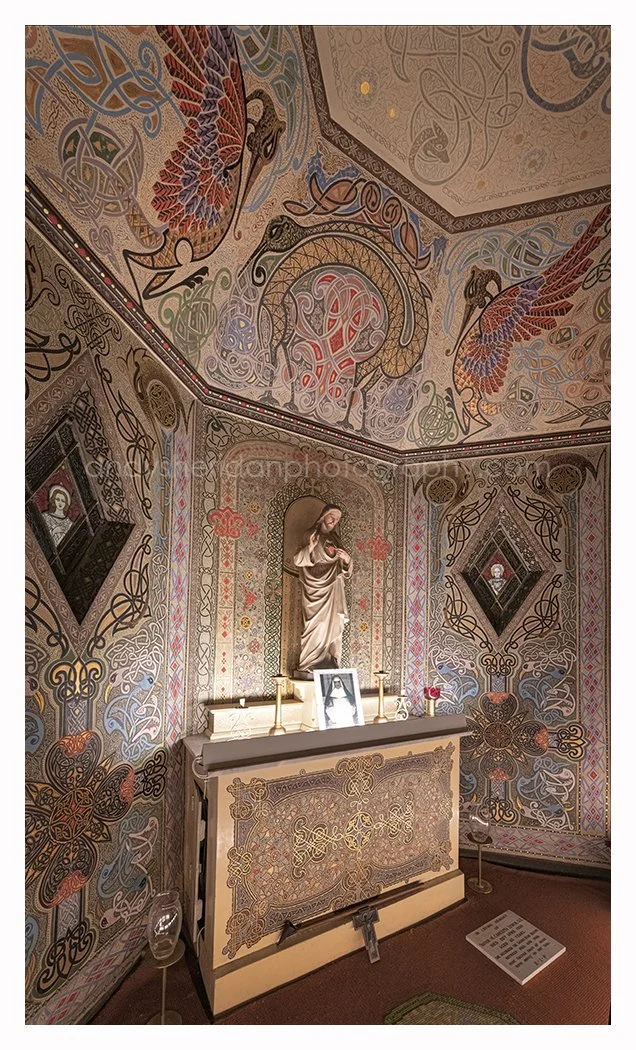As part of the Dun Laoghaire Rathdown Spring Heritage events I was delighted to get the chance to pay a visit to a lesser-known, early 20th century Celtic Revival masterpiece; the Oratory of the Sacred Heart in Dun Laoghaire.
The entrance to the Oratory
The Oratory of the Sacred Heart was built on the grounds of St. Mary's Dominican Convent and dedicated to the Sacred Heart in 1919. The building commemorates the many local Irishmen who fought and died in the Great War. From 1920-1936, its interior was hand-painted by Sister Concepta Lynch, a Dominican nun at St. Mary's
Photo of Sister Concepta Lynch and her cousin in July 1937 - Photo by Dlr Heritage Events
Known familiarly as "Lily", Bridget Mary Lynch was born in Booterstown, Dublin, to Thomas Joseph Lynch a renowned Dublin illumination artist with studios in Harcourt Street, who was known as the King of Celtic Art in the 1880s. Eldest of five, she was his only child to survive infancy. His business specialised in high quality illuminated addresses and he trained her in his trade.
Example of a commemorative address by Dublin artist Thomas J. Lynch - Image by National Library of Ireland
He taught Lily calligraphy and illumination so well that when he died in 1889 she left her school at the Dominican convent, Kingstown (Dún Laoghaire), and took over his studio, which under her direction continued to flourish. However, on 3 July 1896 she entered the Dominican Order at St Mary's convent, where she had been educated.
Dominican Convent National School, Kingstown - Image Dlr Library
Taking the name of Sr Mary Concepta, she taught art, illustrated the school magazine, and was involved with musical activities. Her musical talent was considerable and she wrote hymns, especially in praise of St Teresa of Lisieux, the ‘Little Flower’, to whom she was one of the first devotees in Ireland.
Original Oratory structure, built in 1919 - Photo by RTE
After the first world war a small oratory to the Sacred Heart was built by the order in 1919 in the grounds of St Mary's convent, Dún Laoghaire, to commemorate the peace. The following year Sr Concepta began her life's work of decorating the interior. The project was partly financed by her cousin Seán Glenville and his wife, the actress Dorothy Ward, who held benefit concerts in Liverpool and elsewhere to raise funds.
I will never forget the shock I felt when first walking through the entrance doors to the oratory, and the sheer intensity of it. It was like walking into the Book of Kells. Her achievement is remarkable: she transformed the bare, austere oratory walls with a riot of Celtic colours, shapes, and designs. Some motifs she copied from ancient manuscripts, others of her own invention are strikingly original. She conceived of her work as a whole; though it is complex, intricate and elaborate, it is harmonious.
She managed all this through her practice of using stencils, which allowed for duplication and reverse-duplication of details so that panels are precisely reflected on opposing walls, providing a strong sense of balance to the space.
Harry Clarke provided the seven stained-glass windows in the Oratory, under her direction. As he was still young, they are not outstanding examples of his work but they do manage to complement her art…no easy task!
The ceiling must have been especially demanding for Sister Concepta, with her health failing, as it would have involved mounting scaffolding and painting on her back. The unfinished work does, however, provide us with a valuable insight into her method of sketching and stenciling out of the original forms.
In 1936 arthritis forced her to stop work, leaving the ceiling and part of a wall undone. No doubt the years of breathing in fumes from the lead based paint she used to complete the work was also a significant factor in her early demise. Three years later she died (30 April 1939), and was buried in the convent cemetery.
To my shame I had never heard of this place or the extraordinary art of Lily Lynch. Thankfully the Oratory was not bulldozed with the rest of the school when it was sold off to a shopping arcade developer during the late 1980s. Due to the sterling work of enlightened locals, the National Gallery, the support of the then Minister for Culture (now President) Michael D. Higgins, and the EU Cultural Directorate the building was saved. It is now protected, covered by a surrounding architectural shell designed by the OPW, ensuring future generations can marvel at this incredible work of art.
Additional Information:
See a short documentary on the building by RTE here
Hear a short piece on the building by Tim Carey on Sunday Miscellany here
A book by New Island publishers on the building is available here: Divine Illumination: The Oratory of the Sacred Hear, Dún Laoghaire


















